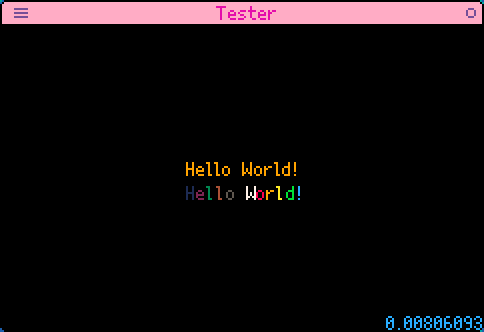I'm writing a simple toy program to get familiar with the API.
I have a string, "Hello World!", that I am intending to print centred horizontally and vertically, adapting to window dimensions on the fly.
In the top line in the screenshot I am printing it in one go, in the bottom line I am printing it letter by letter to enable a "rainbow" effect.

I noticed the two strings are spaced differently, and I realised Picotron in fact uses a variable-width font. I was allotting 5 pixels for each character in my printing routine, but as it turns out the lowercase "l" is one pixel narrower, while the uppercase "W" is one pixel wider.
How do I deal with the variable width of characters for printing and layout work? Is there an API function to get the exact dimensions of a character?
My code:
Incidentally, is there a more compact method of accessing individual characters in a string like was added in PICO-8 (string[i]), or are we expected to purely use the Lua method in Picotron (string.sub(string,i,i))?

In Pico-8, print returns the X-coordinate that the next character would hypothetically start at if it existed. This explicitly supports a pattern of printing something offscreen at X=0 to get the width of the text rendered by the print statement, potentially with a trailing between-letter gap (experiment to find out). So does printing one character offscreen (at x=0, y=-9999 or something) return the one-character width?

Yep, print(print('W',0,-99)) prints 6 as expected, and 4 for 'l'! Thank you!
So, thinking about that then.... The print function could somehow be hooked up recursively to print successive characters in a line. That'll be a fun puzzle to think about! I'll get to it.

It works! And it's computationally cheaper this way, too.

(CPU usage value is only higher than in my previous screenshot because I added more other stuff to my code in the meantime.)
Code:
[Please log in to post a comment]






